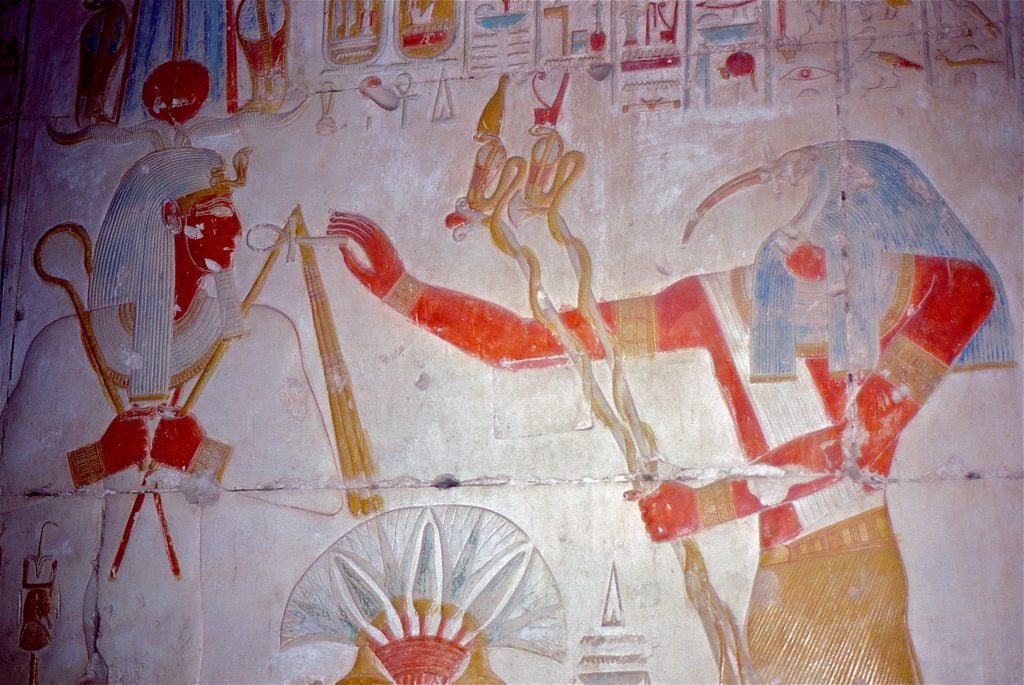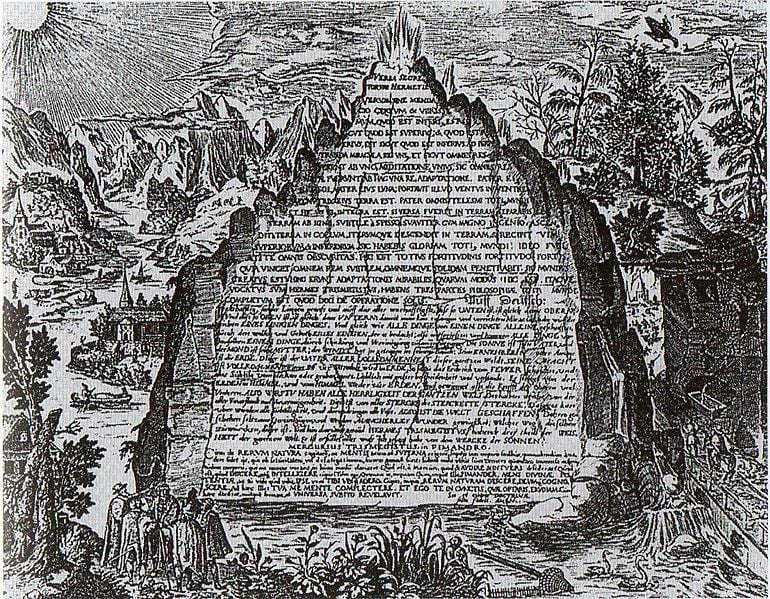
The legendary Emerald Tablet of Thoth is said to be a tablet of emerald or green stone inscribed with the secrets of the universe. The fabled text is a short, almost poetic cryptic summary of early alchemical belief that became one of the pillars of Western alchemy.
Its scribe is purported to be Thoth, the Egyptian god of the moon and of reckoning, learning, and writing. Thoth is the patron of all arts dependent on writing, including medicine, astronomy, and magic.
Given the ancient Greek presence in Egypt following the conquests of Alexander the Great, the name Greeks applied to Thoth is Hermes Trismegistus, meaning “Hermes Thrice-Greatest.”
There are two myths related to Thoth’s birth. The first is that he was born from the seed of Horus, the Egyptian god of order, and the forehead of Seth, god of chaos. The other version is that he was self-created.
Thoth was usually depicted with the body of a human and head of an ibis. His sacred animals were the ibis, the bird associated with wisdom, and the baboon.
According to academic Armando Mei, expert on the Pyramids of Giza and Egyptian art, Thoth “divided his knowledge into 42 plates of emerald, codifying the great scientific principles ruling the Universe…”
“The legend tells that after the gods’ fall, the tablets were cleverly hidden so that no human being might find them,” Mei said. “Only Thoth, on his return to that dimension, was able to recover the mysterious book.”
Legends of the Emerald Tablet of Thoth (Hermes Trismegistus)
The origin of the Emerald Tablet is surrounded by legends. Some of these legends are within a religious framework, while others are based on the time they were formulated. There are also far-fetched explanations and theories. The most common myth has it that the tablet was discovered in a caved tomb under the statue of Hermes in Tyana, clutched in the hands of the corpse of Hermes Trismegistus himself.
Another legend suggests it was the third son of Adam and Eve, Seth, who originally wrote the Emerald Tablet. Others believed that the tablet was once held within the Ark of the Covenant. Some even claim that the source the Emerald Tablet originated from is none other than the mythical city of Atlantis.
Furthermore, there are others that believe that the Emerald Tablet was an Arabic text written between the sixth and eighth centuries AD, rather than a piece of work from antiquity. The most common legend holds that the tablet was found in a caved tomb below the statue of Hermes in Tyana, clutched in the hands of the corpse of Hermes Trismegistus himself. In Thoth, Greeks saw their own god, Hermes, the messenger god, who was also the god of travelers, athletics, and speed.
Was the Book Real?
It is widely believed that the Emerald Tablet was carved into green stone or even emerald, but the actual tablet has never been found. The more scientific description of the origin of the Emerald Tablet comes from the Book of the Secrets of Creation (Kitāb sirr al-ḫalīqa) attributed to Apollonius of Tyana, an ancient Greek philosopher, teacher and one of the most famous miracle workers of his day.
There are theories that it is an Arabic translation of an earlier but no longer extant Greek work. It is uncertain whether it was a translation of an earlier work or an original composition in Arabic. The book as a whole is an encyclopedic treatment of several topics, many of which were alchemical concoctions and magical talismans.
Since the Emerald Tablet in its actual form has never been found, many believe that it is merely a legend and may have never existed at all.
The history of the tablet may be confusing and disputed, but the influence of the text is not. Later scholars translated the Arabic manuscripts into Latin, English, and other languages, and numerous commentaries have been written regarding its contents.
The Greeks identified the Egyptian god Thoth with their messenger god, Hermes, who they believed to be the divine author of the Emerald Tablet. The claim regarding the authorship was first made around 150 to 215 AD by the church father Clement of Alexandria. For this reason, the Emerald Tablet of Thoth has also been known as the Emerald Tablet of Hermes throughout history.
It is said that the Emerald Tablet was part of a group of philosophical texts known as Hermetica which reveals the wisdom of the universe. By the nineteenth and twentieth centuries, it had become associated with esotericists and occultists.

The Esoteric Text
The tablet is a piece of esoteric text, but according to various interpretations, it may possess clues to the creation of gold, making it highly valuable to Western alchemists. Since antiquity, people have been trying to transform base metals, particularly gold and silver, into precious ones. It is said that the text in the tablet describes the different stages of alchemical transformation.
Moreover, the Emerald Tablet is believed to reveal the process of creating a philosopher’s stone—the ultimate material needed to transform any metal into gold. It was highly sought after for thousands of years and believed to be useful in the derivation of an elixir of everlasting life. It is thought of as a medicine which could cure diseases, bring spiritual change, prolong life, and even grant immortality.
Some texts in the tablet are incorporated into various beliefs and philosophies, such as the words “As Above, So Below.” These words describe the idea that the universe consists of the physical (below) and the spiritual (above) and things that happen in the physical world happened in the spiritual world, too.
Accordingly, the human body is structured in the same way as the universe, meaning if we understand the body, we can gain insight into the universe as well. The Emerald Tablet fascinated scholars and scientists. English physicist Isaac Newton made his own translation of the text. Many believe that the tablet could have influenced Newton on the laws of motion and the theory of universal gravity.
Purportedly, Newton spent thirty years on uncovering the formula for the philosopher’s stone, as evidenced by his papers. Only very recently were scientists able to look at the papers of Sir Isaac Newton, as they had been purchased and kept in a vault by the famed economist John Maynard Keynes.
See all the latest news from Greece and the world at Greekreporter.com. Contact our newsroom to report an update or send your story, photos and videos. Follow GR on Google News and subscribe here to our daily email!



